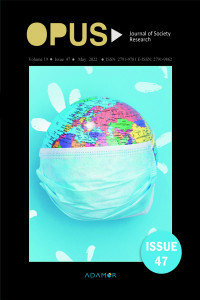Halkla İlişkiler Mesleğinin Toplumdaki Algısı: Elazığ İli Örneği
Halkla İlişkiler, Algı, Meslek, Toplum
The Perception of Public Relation Profession in The Society: Example of Elazığ City
Public Relations, Perception, Profession, Society,
___
- Abbott, A. (1988). The system of professions: an essay on the division of expert labor. Chicago: the university of chicago press.
- Abdullaha, Z. and Threadgoldb, T. (2008). Towards the professionalisation of public relations in Malaysia:Perception management and strategy development. Public Relations Review ,34 , 285–287.
- Bernays, E. L. (1992). Securing the future of public relations. pr update, 2(1), 8-9.
- Bernays, E. L. (1993). The future of public relations: is licensing the answer?, Journal Of Corporate Public Relations, 3, 8 - 10.
- Cameron, G., Sallot, L., and Weaver-Lariscy, R. (1996). Developing standards of professional performance in public relations. Public Relations Review, 22(1),42–62.
- Cornelissen, J. P. (2004). Corporate communication: Theory and practic, London: Sage Publication.
- Eke, B. (1987). Bir sosyal sınıf belirleyicisi olarak meslek faktörü. istanbul üniversitesi iktisat fakültesi mecmuası, 43, Prof. Dr. S. F. Ülgener’e armağan, 377-401.
- Grunig, J. E., and Hunt, T. (1984). Managing public relations. forthworth, United States: Harcourt Brace Jovanovich College Publishers.
- Johnson, T. J. (1972). Professions and power. London: The Macmillan Press Ltd.
- Kuzgun, Y. (2000). Meslek danışmanlığı. Ankara: Nobel Yayın Dağıtım.
- L’etang, J. (2002). Public relations education in britain: a review at the outset of the millennium and thoughts for a different research agenda. Journal of Communication Management, 7(1), 43–53.
- Macit, M. (2007). Büyüyünce ne olmak istersin?:Bir kimlik belirleme sorusu olarak iş/meslek üzerine sosyolojik bir yaklaşım. Ekev Akademi Dergisi, 30, 35-50.
- Mutlu, E. (1994). Iletişim sözlüğü. Ankara:Ark Yayınları.
- Oyserman, D., Elmore, K., and Smith, G. (2012). Self, self-concept, and identity. In M. R. Leary, and J. P. Tangney (eds.) (2nd ed.)., Handbook Of Self And Identity (69–104). New York, Ny: The Guilford Press.
- Öksüz, B. (2015). Halkla ilişkilerde meslekleşme sorunu. Iletişim Kuram Ve Araştırma Dergisi , 40, 249-265.
- Hocke-Mirzashvili, T. M., and Hickerson, C. (2014). US public relations educators' identification and perception of the discipline. Public Relations Review, 40(1), 100-106.
- White, C. and Park, J.(2010). Public perceptions of public relations. Public Relations Review, 36(4), 319-324.
- Wright, D. K. (2011). History and development of public relations education in north America. Journal of Communication Management, 15(3), 236–255.
- Yildirim, G. and Akbulut, D. (2017). Halkla ilişkiler ve tanıtım programlarında öğrenim gören öğrencilerin yakınlarının halkla ilişkiler mesleği konusunda tutum ve algıları üzerine bir araştırma. Akdeniz Iletişim Dergisi, 28, 199-223.
- Yilmaz, A. andTanriverdi, H. (2017). Aşçıların meslek uyumu ve meslek algısı düzeyleri üzerine bir araştırma. Karabük Üniversitesi Sosyal Bilimler Enstitüsü Dergisi, 7(2), 621-639.
- Yayın Aralığı: 6
- Başlangıç: 2011
- Yayıncı: ADAMOR Toplum Araştırmaları Merkezi
Türk Kamu Örgütlerinde Kadın Yönetici Olmak: Gaziantep İli Örneği
Üniversite Gençliğinin Değerleri: 20 Yıl Sonra Ne Değişti?
Abdullah TOPÇUOĞLU, Gamze AKSAN
Norveç’te Refah Devletinin Ortaya Çıkışı ve Gelişimi
Mahmut KÜÇÜKOĞLU, Hüseyin ERCAN
Lider Üye Etkileşimi ve Çatışma Yönetim Stili İlişkisi: Bir Alan Araştırması
Sami Sonat ÖZDEMİR, Düriye BOZOK
Lise Öğrencilerinin STEM’e Yönelik Tutumlarının İncelenmesi
Zehra DOĞAN ÇALIŞKAN, Mehmet ÇAKMAK
Halkla İlişkiler Mesleğinin Toplumdaki Algısı: Elazığ İli Örneği
